Max Factor (1945-1960)
Continued from: Max Factor (1930-1945)
Continued onto: Max Factor (post 1960)
After the pent-up demand for cosmetics created by war shortages was satisfied, over production by cosmetic companies created a glut and consumers in the United States were spoilt for choice.
Max Factor’s gross sales fell from US$17,053,040 in 1946 to US$14,437,389 in 1950 with a corresponding drop in net income from US$2,612,136 to US$858,252. The company’s margins were also affected by increases in the price of raw materials, containers and labour requiring Max Factor to raise its prices in the United States by 10% across the board in October, 1950. Intense competition during the 1950s made it difficult for the company to institute further price hikes even though its margins were put under further pressure from its greater use of expensive television advertising.
As a mass-marketing medium, television dramatically affected the sale of cosmetics in the United States in the 1950s. It was the main reason why Revlon’s share of the American lipstick market rose from 15 to 28% in 1956, and Coty’s from 3½ to 8%. Lipsticks were an important ‘fashion cosmetic’ in the 1950s and, as Max Factor’s lipstick sales languished at about 1½% in the United States, the company had to get more involved in the medium.
See also: Lipstick Wars
By 1955, things had improved somewhat. Max Factor’s gross profit had risen to US$18,946,795 with net earnings of US$2,418,324. By then, space had become a problem and the company constructing a new building at 1655 North McCadden Place, Hollywood, adjacent to the Max Factor Studio on Highland Avenue. Opened in 1956, it housed the laboratories, executive offices, sales, advertising, promotion and public relations departments.

Above: 1956 The new building built at 1655 North McCadden Place, Hollywood, adjacent to the building on Highland Avenue.
After being remodelled, the older building on Highland Avenue was largely given over to manufacturing with automation being introduced where possible to help keep labour costs down.
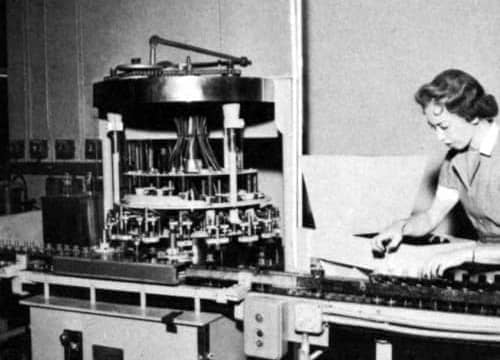
Above: 1956 Automated bottling equipment and a portion of the auxiliary packaging and assembly line in the refurbished Highland Avenue building.
Outside North America, Max Factor continued to expand. By the time the company celebrated its golden jubilee in 1959, it had opened new branches in Australia, South Africa, Argentina and Brazil (1946), Ireland (1947), Italy (1948), Japan (1953), and India (1954).
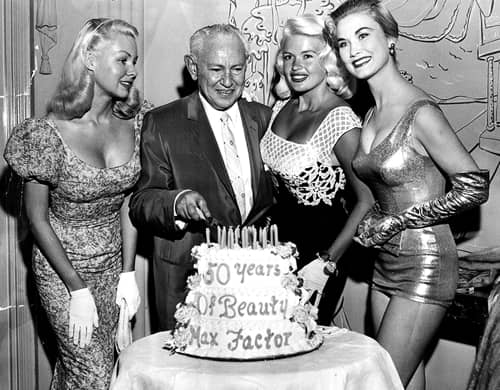
Above: 1959 Max Factor Jr. with Joi Lansing [1929-1972], Jayne Mansfield [1933-1967] and Arlene Howell [b.1939] at the Max Factor golden jubilee celebration.
Also see the booklet: Max Factor Beauty Secrets (c.1959)
The company also built new offices and factory space for the Canadian branch in Toronto, (1956), constructed a new French factory in Pantin (1956) and another in Mexico City (1958), begun moving its American manufacturing operations into a new manufacturing plant in Hawthorn, California, and opened a new factory in Bournemouth, England (1959), superseding the one completed in 1947.
See also: Max Factor Factory
In 1956, Max Factor also absorbed Sales Builder – the distribution company it had bought in 1946 – and it became the Sales Division for Max Factor in the United States.
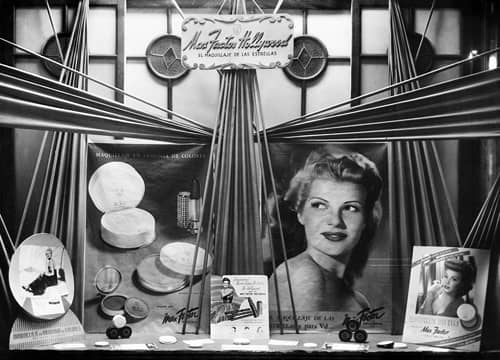
Above: 1948 Max Factor window display in the Del Aguila Pharmacy, Buenos Aires, Argentina.
Hollywood
Max Factor had depended heavily on its links with Hollywood to promote its cosmetics but this marketing strategy came to an end with the break-up of the Hollywood studio system in the 1950s.
Under the studio system, production and distribution of Hollywood films was dominated by a small number of Hollywood studios that controlled their movie stars through long-term contracts. The collapse of the studio system – which began in earnest in 1948 and was largely complete by 1954 – saw the end of these long-term contracts and the end of Max Factor’s cheap endorsement links with Hollywood. Pan-Stik Make-up and Color-Fast Lipsticks appear to be the last Max Factor products endorsed by movie stars, with Elizabeth Taylor, Esther Williams, Donna Reed, Janet Leigh, Debbie Reynolds and Jane Russell being amongst the last actresses to do Max Factor promotions. By 1955, the company had stopped using the tag line ‘Cosmetics of the Stars’ and thereafter its advertising became more like other cosmetic companies.
Professional make-up
Max Factor continued to make Greasepaint and Pan-Cake Make-up for stage and screen. In 1946, the company adapted its Pan-Cake make-up for black and white television and the following year introduced Pan-Stik, a creamy, greaseless make-up in stick form. Like Pan-Cake, professional forms of Pan-Stik were customised to make them suitable for black-and-white and coloured film stocks as well as black-and-white and later colour television.
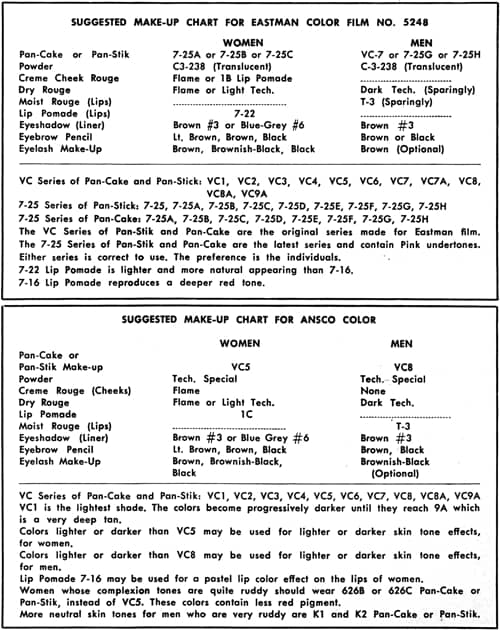
Above: 1955 Max Factor colour charts for Pan-Cake and Pan-Stik makeup for Eastman and Ansco color film.
In 1954, Max Factor developed a new make-up specifically for RCA-Victor compatible colour televisions – the standard transmission system for colour television used by all the major American networks. Developed with the assistance of the Color Research Department of the National Broadcasting Company (NBC), an RCA affiliate, it was marketed to the industry as Max Factor’s Color TV Make-up and sold in both Pan-Cake and Pan-Stik forms.
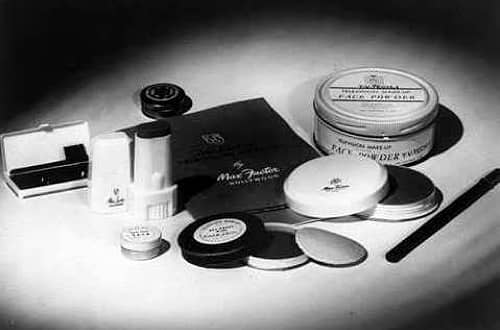
Above: 1958 Max Factor make-up for television.
Also see the company booklet: Television make-up for black-and-white and color television (1958)
When Max Factor introduced its Hi-Fi Fluid Make-Up the following year, it tried to link its development with colour television in the same way it had previously connected its Society Make-Up with motion pictures. However, without the backing of movie or televison stars in its advertising it was not nearly as effective.
Today Max Factor brings you a new concept in make-up, a discovery that makes possible new subtle colors that give you a look of radiant natural beauty all other make-ups have strived for without success. He calls this great new make-up Hi-Fi. …
This new idea in color for make-up was developed to fill an urgent need created by color television. Existing colors in make-up appeared harsh, unflattering, unnatural. So the great TV studios called in Max Factor because of his tremendous experience in color research for make-up.
And Max Factor created for their exclusive use, the new concept in make-up colors that was needed … a concept which faithfully reproduced skin tones that stay smooth and radiant under the most glaring light.(Max Factor advertisement, 1955)
General cosmetics
As its ability to call on movie stars to sell its products declined, and competition from other cosmetic companies like Revlon increased, Max Factor moved to bolster its traditional strength in make-up while attempting to improve those areas in which it was weak – skin-care, hair-care, the youth market, men’s toiletries and fragrances. To help this process the company established a Project Development Department in 1956 to create new products and packaging.
Skin-care
Max Factor made some adjustments to its skin-care range in the late 1940s adding Satin Flow Cleansing Cream in a squeezable, plastic dispenser and Night Facial Stik for dry skin in 1949 as part of its ‘New Worlds of Beauty’ promotion.
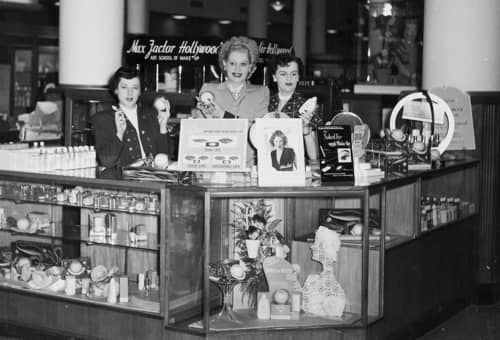
Above: c.1950 Max Factor department store counter with demonstrators holding World of Beauty Lotion Purse Dispenser and World of Beauty Lotion (left), World of Beauty Lotion (centre) and Satin Flow Cleansing Cream (right).
Satin Flow Cleansing Cream: “It’s feather-light, penetrates faster, removes make-up easily and thoroughly, leaves your skin immaculate, cool, refreshed.”
Night Facial Stik: “[T]he new way to guard against dryness and keep the face and throat soft, smooth, young-looking, without annoying excess film to soil hair and linens.”
These new preparations required some adjustment to the company’s suggested skin-care routines for dry, oily and normal skin types.
Care for normal skin
Night: Cleanse with Satin Flow Cleansing Cream. Stroke on Night Facial Stik lightly.
Morning: Refresh skin and prepare it for make-up with Skin Freshener. Protect skin with Invisible Make-up Foundation.
Care for dry skin
Night: Cleanse with Satin Flow Cleansing Cream. Stroke Night Facial Stik over face and throat for overnight care.
Morning: Refresh skin and prepare it for make-up with Skin Freshener. Protect skin with Invisible Make-up Foundation.
Care for oily skin
Night: Cleanse with Satin Flow Cleansing Cream. Apply Astringent generously
Morning: Apply astringent again. If skin is very oily use Astringent Foundation, otherwise use Invisible Make-up Foundation.(The new art of make-up, 1950, p. 23)
Secret Key
This simplistic skin-care routine was updated after the introduction of Secret Key (1954), a skin toner designed to correct the acid-alkaline balance of the skin, an idea Max Factor may have tried before with its Normalizing Cleansing Cream (1938). By removing the ‘alkaline barrier’ and restoring the normal acid mantle, Secret Key was supposed to make skin creams more effective and help make-up hold its colour.

Above: 1957 Max Factor Secret Key.
Secret Key: “[R]eturns the skin to the acidity-alkalinity balance characteristic of a young, healthy skin. It brings back a natural freshness and radiance that you cannot get from a surface cosmetic. And, by returning your skin to the correct acidity-alkalinity balance, Secret Key opens the way for treatment creams and lotions to do their beautifying work.”
See also: Acid Creams
Max Factor combined Secret Key with other products developed in 1954 or 1955 – Gentle Foam Cleanser, Double-Depth Cleansing Cream, Enriched Hormone Cream, Active Moisturizer, Vita-Night Cream, Facial Pack, Clear-Up and Velvety Night Cream – to form a series of treatment groups.
Double Depth Cleansing Cream: “[S]cientifically designed to penetrate and remove soil and make-up that soap and water cannot remove.”
Enriched Hormone Cream: “Provides essential rich oils for dry skin, plus active hormone ingredients to stimulate water-holding power of your own skin cells! Plumps out dry lines, keep skin looking youthful!”
Active Moisturizer: “[T]o replenish both oil and moisture and prevent your skin from feeling dry and parched.”
Gentle Foam Cleanser: “[A] pearly liquid to completely cleanse your skin of excess oil and clogging make-up.”
Facial Pack: “[A] cooling and conditioning mask to be used at least twice a week.”
Vita-Night Cream: “[A] light vitamin cream that absorbs the oils your skin secretes overnight.”
Clear-Up: “A tinted medicated lotion … to dry up blemishes and conceal them at the same time … can be used on individual ‘spots’ as a cover-up, or as a light make-up over the entire face.”
Velvety Night Cream: “[I]s a smooth, light night cream especially formulated for dry or normal skins.”
The Secret Key Treatments Groups were organised by skin type which now included disturbed as well as normal, oily and dry types.
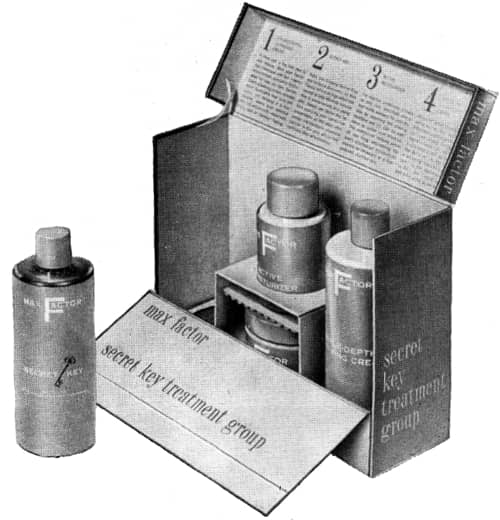
Above: 1957 Max Factor Secret Key Treatment Group for dry skin in new turquoise packaging.
To correct a dry skin, use Secret Key together with the related creams formulated for the dry skin: Double-Depth Cleansing Cream, Enriched Hormone Cream and Active Moisturizer (a new type of moisturizer that remains active on your skin all day under make-up).
To correct an oily skin, use Secret Key together with the related creams formulated for the oily skin: Gentle Foam Cleanser, Facial Pack and Vita-Night Cream (uses Vitamins A and D to absorb and gradually correct excess oiliness).
To correct a disturbed skin, use Secret Key together with the related creams formulated for the disturbed skin: Gentle Foam Cleanser and Clear-Up (a new skin-tinted antiseptic lotion that conceals and at the same time helps to correct unsightly skin blemishes).
To soften and smooth a normal skin, use Secret Key together with the related creams formulated for the normal skin: Double-Depth Cleansing Cream, and Velvety Night Cream.(Max Factor advertisement, 1955)
In 1980, the Japanese branch of Max Factor acquired rights to a yeast-based substance called pitera and included it in Secret Key, renaming the product Max Factor SK-II. In 1995, Procter & Gamble would take this product, dump the Max Factor name, and expand it into the SK-II prestige cosmetic brand we know today.
Other skin-care products added during the 1950s included Cup of Youth (1957), a late entry into the hormone cream market, and Eye Cream Plus (1958).
Cup of Youth: “[A] balanced blend of emollients, moisturizers and estrogens … moisturizes and smooths as no other cream can—helps your skin become younger-looking.”
Eye Cream Plus: “[S]pecially designed to care for the tissue around your eyes. Patted in nightly, it discourages ‘crows feet’ and tiny lines.”
Max Factor skin-care cosmetics of this period used vitamins and hormones but I have found no evidence that the company got involved with the skin-care crazes of the 1950s such as turtle oil, royal jelly, or placental extracts. Their one craze aberration occurred later when the company joined Helene Curtis, Coty, Hazel Bishop and Revlon and released an albumin wrinkle smoother, Max Factor Touch of Youth Wrinkle Smoothing Lotion, in 1964. Like other products of this type it got the company into difficulties with the American Food and Drug Administration (FDA).
See also: Albumin Wrinkle Smoothers
Make-up
An examination of the company’s product range in 1950 reveals that it was, with the exception of Pan-Stik, generally the same as that of the pre-war period with the Color Harmony colour range largely unaltered and still reliant on stage and screen inspired numbering for many of its shade names. This would not last for much longer. Pan-Stik did not have any of its colours named with a number and from here on Max Factor would introduce new shades of make-up using names with greater marketing appeal.
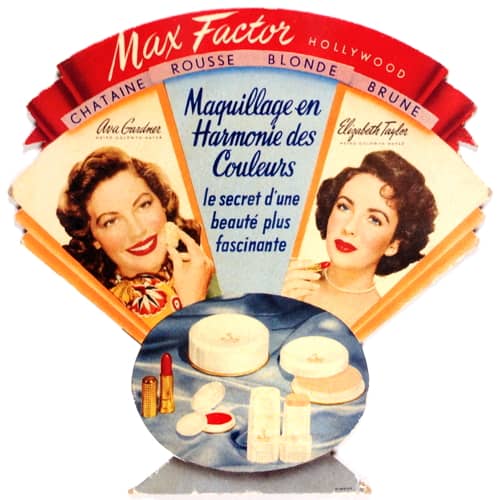
Above: Max Factor Color Harmony make-up – Face Powder, Pan-Cake, Pan Stik, Rouge and Lipstick (France).
1950 Product List (Max Factor ★ Hollywood, U.S.) included:
Make-up including Pan-Cake Make-Up (Shades: Cream No. 1, Cream-Rose, Cream No. 2, Amber No. 1, Amber-Rose, Amber No. 2, Natural No. 1, Natural-Rose, Natural No. 2, Tan No. 1, Tan-Rose and Tan No. 2); Pan-Stik Make-up (Shades: Fair, Natural, Medium, Olive, Deep Olive, Golden Tan, Deep Tan); Face Powder (Shades: Rachelle, Rachelle-Rose, Rachelle No. 2, Amber No. 1, Amber-Rose, Amber No. 2, Natural, Natural-Rose, Olive, Olive No. 2, Sum’r Tan, Tan-Rose, Brunette, Ochre, Flesh); Invisible Make-Up Foundation; Cream Rouge (Shades: Flame, Blondeen, Carmine, Raspberry); Rouge (Shades: Clear Red No. 1, Blue Red, No. 1, Rose Red No. 1, Clear Red No. 2, Blue Red, No. 2, Rose Red No. 2, Clear Red No. 3, Blue Red, No. 3, Rose Red No. 3, Flame, Blondeen, Carmine and Raspberry); Eyebrow Pencil (Shades: Black and Brown); Eyelash Make-Up (Shades: Black, Brownish-Black and Brown); Eyeshadow (Shades: Brown, Gray, and Blue); Lipstick (Shades: Clear Red No. 1, Blue Red, No. 1, Rose Red No. 1, Clear Red No. 2, Blue Red, No. 2, Rose Red No. 2, Clear Red No. 3, Blue Red, No. 3, Rose Red No. 3, Pink Secret, Pink Velvet, Coral Glow, Wild Orchid, Blue Twilight and Purple Dawn); Tru-Color Lipstick (Shades: Orange Red, Light Red, Vivid Red, Medium Red, Natural Red, Deep Red); Lip Gloss; and Make-Up Blender (Shades: Flesh, Rachelle, Natural, Medium, Olive and Sum’r Tan).
Skin care cosmetics including Astringent, Astringent Foundation (formerly Honeysuckle Cream), Dry Skin Cream, Cleansing Cream, Melting Cleansing Cream, Skin Freshener and Talc.
Assorted sundries including Brillox (Liquid and Jelle), Facial Soap, a Face Powder Brush and a Lip Brush.
Color Harmony was still used to group women into one of four colour types – Blondes, Brunettes, Redheads and Brownettes but, by 1950, this had been expanded to include Gray-Haired types – White Haired, Gray Blondes, Gray Brunettes, Gray Redheads and Gray Brownettes – previously described as Titian.
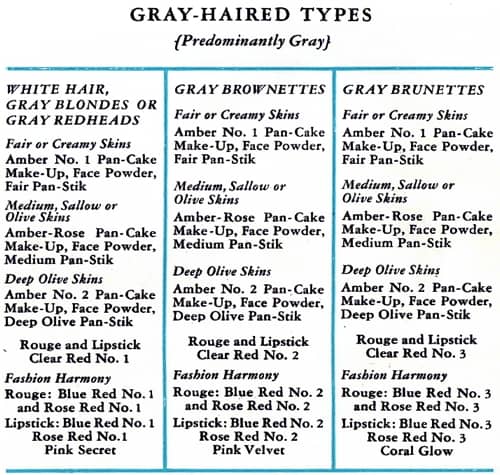
Above: 1950 Max Factor Color Harmonies for Gray-Haired Types.
Also see the booklet: Color Harmony Make-up Chart (1950)
Hi-Fi
An important development for Max Factor in the 1950s was the introduction of Hi-Fi (1955), the company’s first new general make-up range since Society debuted in 1927. As mentioned earlier, Max Factor claimed that it had been developed through the company’s research into make-up for colour television. To emphasise the point, mirrors pictured in advertisements were shaped like television screens even though the name of the make-up was supposed to invoke comparisons with high-fidelity sound.
Hi-Fi: “[D]oes for skin colour tones what high fidelity does for sound . . . achieves delicate graduations of colour never before possible . . . makes your natural skin tone come vibrantly alive.” Shades: Fair Tone, Tempting Tone, Blush Tone, Candle Tone, Gay Tone and Sun Tone.
The first two products in the range were Hi-Fi Fluid Make-Up and Hi-Fi Fluid Rouge. Hi-Fi Fluid Make-Up, a liquid foundation, was introduced in six shades: Fair Tone (fair) for a light fair skin; Tempting Tone (natural) for a creamy ivory skin; Blush Tone (medium rose) for skins with neutral tones; Candle Tone (medium) for a medium or ruddy skin; Gay Tone (deep natural) for an olive skin; and Sun Tone (tan) for a suntanned or a very deep olive skin. These were cool, beige colours rather than the creamy peaches or tans of the past.
Hi-Fi Fluid Make-Up: “[I]n new high fidelity skin tones makes you took exquisite, never ‘made-up’ . . . in any light! Reproduces natural complexion tones more perfectly than ever before.” Shades: Fair Tone, Tempting Tone, Blush Tone, Candle Tone , Gay Tone and Sun Tone.
After starting with foundation and rouge, the Hi-Fi range quickly expanded into other areas of make-up, beginning with Hi-Fi lipsticks in 1956, Max Factor’s first new lipstick formulation in five years. These new indelible lipsticks came in a jeweller-designed gilt ‘celebrity’ case with an automatic (quick-change) refill, a design idea introduced into a number of other lipsticks in the 1950s including Helena Rubinstein’s Stay-Long lipsticks (1951) and Revlon’s Futurama cases (1955). By the end of the decade the Hi-Fi lipstick range included over two dozen matt, gloss and iridescent shades.
Other Hi-Fi products added in the 1950s included Hi-Fi Cream Mascara (1957), Hi-Fi Eye Shadow (1957) and Hi-Fi Eye Shadow Stick (1958). Collectively these three lines dramatically extended Max Factor’s eye make-up shade ranges.
Foundations and face powders
The company’s best selling Pan-Cake make-up continued to be a major focus for Max Factor but was now complemented with the previously mentioned Pan-Stik (1947) released as a general make-up in 1948 in five ‘color harmony’ and two ‘sun tan’ shades.
Pan-Stik: “[T]he creamy make-up in new convenient skick form. No puff, no sponge, can’t spill or leak in your purse.” Shades: Fair, Natural, Medium, Olive, Deep Olive, Golden Tan and Deep Tan.
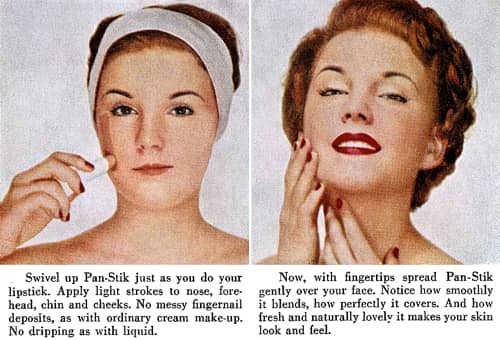
Unlike Pan-Cake, which usually had to be completely renewed when it began to fail, Pan-Stik could be touched up. Its revolving base was turned like a lipstick until the make-up projected above the case, after which it was dabbed across the forehead, nose, cheeks and chin, and then blended in with the fingertips – upwards and outwards from the centre of the face – before being covered with a light covering of matching powder.
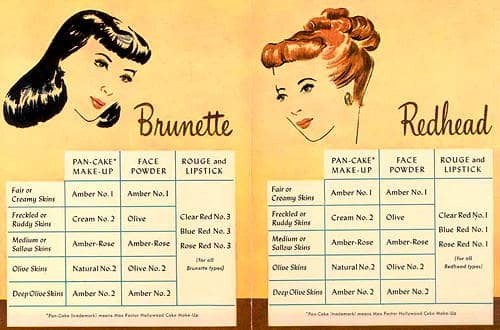
Above: 1950 Color Harmony chart for Pan-Cake and Pan-Stik make-up to suit Brunettes and Redheads.
Also see the company booklet: Max Factor Hollywood Color Harmony Make-up Chart (1950)
In 1953, Max Factor added Creme Puff Make-up which blended a creamy make-up base with powder, the same year that Revlon introduced its compact powder, Love Pat. Applied with a puff from a hinged, mirrored compact it came in five shades.
Creme Puff: “It brings to your skin a smooth flawless finish that lasts for hours . . . that veils tiny lines instantly and always feels fresh and light. A make-up that can’t dry your skin or absorb natural skin moisture because it’s blended to super-smoothness with lanolin rich creams.” Shades: Truly Fair, Tempting Touch, Candle Glow, Grey Whisper, and Sun Frolic. Two additional shades were added later in the year: Twilight Blush and Sun Goddess.
The addition of Creme Puff meant that Max Factor had most of the main types of foundation – pan-cake, cream cake, stick, and liquid – covered. In 1954, the company then added Erace, a stick concealer in five shades: Fair, Medium, Deep Natural, Tan and Deep Tan, with White Erace released much later in 1968. Erace has often been described as the first stick concealer but this is not the case. That honour goes to Covermark’ Spot-Stik introduced back in 1936.
See also: Covermark
Lipstick
In 1946, Max Factor returned to packaging its lipsticks in metal containers, eliminating the white plastic caps it had introduced during the packaging shortages of the Second World War. The new case came with a reformulated indelible lipstick in twelve shades with a Clear Red, Blue Red and Rose Red for each of Max Factor’s four colour types with Pink Velvet, Coral Glow, and Pink Secret shades added in 1948.
| Blondes: | Clear Red No. 1 | Blue Red No. 1 | Rose Red No. 1 |
| Brunettes: | Clear Red No. 3 | Blue Red No. 3 | Rose Red No. 3 |
| Brownettes: | Clear Red No. 2 | Blue Red No. 2 | Rose Red No. 2 |
| Redheads: | Clear Red No. 1 | Blue Red No. 1 | Rose Red No. 1 |
Above: 1946 Max Factor Hollywood Lipsticks shades.
During the American ‘Lipstick Wars’ of the 1950s the company released another indelible called Color-Fast (1952), the older lipstick now being referred to as Regular. By then, Max Factor had embraced more marketable shade names, an indication of the increasing influence of Revlon.
Color-Fast Lipstick: “[A]n amazing new non-smear type lipstick with ‘stay-on lustre’ that won’ blot away, won’t fade away, won’t wear away. You smooth on this lanolin-rich, creamy, non-drying lipstick. hours later . . . after dinner, after coffee, after that last kiss . . . its satiny ‘stay-on lustre’ will still be on your lips!” Shades: Party Pink, Golden Flame, Wild Orchid, Coral Spray, Cheery Cherry, Red Red Rose, Clearly Red and Brighter Red with Jill-In-The-Box added later in the year. Later shades included: Riding Hood Red (1953); See Red (1954); and Crushed Rose and Red Tape (1955).
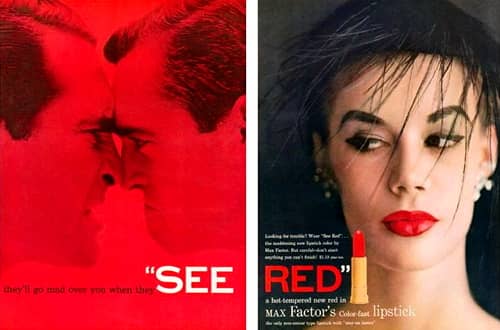
Above: 1954 See Red shade of Color-Fast Lipstick.
See also: Lipstick Wars
The previously mentioned Hi-Fi Lipstick, added in 1955, was also made with a long-lasting formulation.
Hi-Fi Lipstick: “[E]verything you want in one lipstick. The brilliant high fidelity color won’t come off until you take it off! No blotting, no setting, no drying.” Shades: Clear Clear Red, Sparkling Scarlet, Brilliant Red, Luminous Pink, Shimmering Rose, Blazing Ruby, Electric Pink, Dazzling Coral and Flaming Orange. Additional shades added through to 1960 were Red Contrast (1956); Roman Pink, and Calypso Beat (1957); Pink’n Orange, and Sparkling Scarlet (1958); Pink Jade, Goldfire Red, and Goldfire Frost (1959); and Café Frappé, and Coffee Toffee (1960).
Max Factor added Iridescent Magic Lipsticks in 1959 in pearlescent shades: Essence of Pearl, Golden Frost, Petal Frost, Flamingo Pearl, Apricot Frost, Orchid Pearl and Desert Pearl shades. Essence of Pearl was colourless so could be used under or over other lipsticks to add iridescence to any lipstick colour.
The other major addition during the decade was the creation of Hi-Society cases which combined a mirror and lipstick all-in-one. Introduced in 1958, the cases could be fitted with a creamy-moist Hi-Society or long-lasting Hi-Fi lipstick.
Rouge
After the Second World War, Max Factor continued to make compressed powder (cake) and cream rouge in shades that included Flame, Blondeen, Carmine, Raspberry, Clear Red No. 1, Clear Red No. 2, Clear Red No. 3, Rose Red No. 1, Rose Red No. 2, Rose Red No. 3, Blue Red No. 1, Blue Red No. 2, and Blue Red No. 3, some of which had been around since the 1930s. A liquid rouge, Hi-Fi Fluid Rouge, was added in 1955 as a part of the new Hi-Fi range but only came in three shades.
Hi-Fi Fluid Rouge: “[F]or a beautiful touch of subtle new high fidelity color.” Shades: Clear Red Tone, Blush Tone and Coral Tone.
Eye make-up
As mentioned earlier, Max Factor extended its eye make-up range in the 1950s largely through additions to the Hi-Fi range which was sold in a much wider range of colours than its pre-war counterparts. In 1958, the company added Hi-Fi Eyeshadow Stick in 17 shades and Hi-Fi Fluid Eye Liner in 13 shades. An automatic mascara, Max Factor Wand Mascara was also added in 1958 in Blue, Black, Blue-Green, Jet Gray, Brownish Black, Green, Brown and Lavender shades, one year after Helena Rubinstein launched the first automatic mascara, the Mascara-matic.

Above: Max Factor Wand Mascara.
Like the Mascara-matic the Max Factor wand used a grooved metal stick but it was refillable, the first automatic mascara on the market to be so.

Above: 1960 Max Factor Mascara Wand with triple refill, Hi-Fi Fluid Eyeliner, Automatic Eye Pencil and Eye Shadow Stick (Australia).
See also: Automatic Mascara
The addition of these products in a wide range of shades meant that Max Factor now had a comprehensive range of eye make-up.
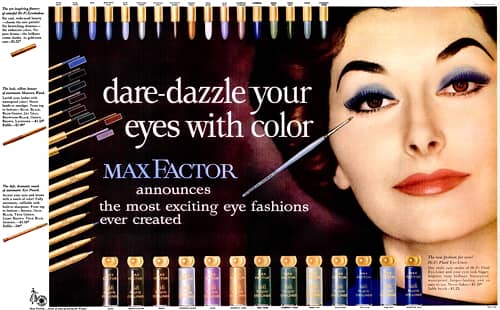
Above: 1959 Max Factor eye make-up. The shades displayed are:
Top: Hi-Fi Shadow Sticks in Azure Blue, Blue-Green Blue, Iridescent Blue, Blue Mist, Iridescent Silver, Iridescent Gray, Iridescent Brown, Golden Frost, True White, Blue Mist, Iridescent Lavender, Lavender, Green Mist, Green Jade, Green and Iridescent Green shades.
Side: Mascara Wand in Blue, Black, Blue-Green, Jet Gray, Brownish-Black, Green, Brown, and Lavender shades; and Eye Pencils in Brown, Gray, Black, True Green, Light Brown, True Blue, and Auburn shades.
Bottom: Hi-Fi Fluid Eyeliner in Black, Brown-Black, Brown, Iridescent Silver, Lilac, Iridescent Gold, True Green Iridescent Green, Green Mist, Blue-Green, True Blue, Blue mist, and Iridescent Blue shades.
Gaps in the range
The 1950s saw Max Factor take some steps in rectifying weaknesses in segments of the market in which it had little or no presence – the youth market, hair-care and men’s toiletries.
Youth market
As mentioned earlier, the Secret Key treatment regimes introduced by Max Factor in 1955 included one for disturbed skin. In 1959, Max Factor added two new skin preparations specifically designed for younger, problem skins: Skin Clear Medicated Cleanser and Skin Clear Medicated Foam, both containing the antibiotic tyrothricin and the antiseptic G-11 (hexachlorophene).
See also: Hexachlorophene
Hair-care
Hair-care products including home permanents, hair colouring kits and hair sprays became popular after the war but Max Factor had almost nothing in this sector of the market apart from Brillox, a hair brilliantine.
In 1955, Max Factor (U.S.) created a Pharmaceutical Division to develop new toiletries now branded as pharmaceuticals by the American Food and Drug Administration (FDA). Its first product was Sebb (1955), a dandruff treatment – containing an antimicrobial (benzethonium chloride) and a fungicide (N-trichloromethylmercapto-4-cyclohexene-1,2-dicarboximide) – sold in Britain as Banish the following year. I assume the Sebb name was a reference to seborrheic dermatitis.
Sebb: “Just shake it on your scalp right out of the bottle. Then comb your hair and forget it. Sebb is not the least bit oily or greasy, so there’s no mess. Sebb has no medicinal odor, just a mild pleasant scent.”
Max Factor filled some of its gaps in hair-care through acquisition. In 1956, it bought Lee Ltd. of Beverly Hills, the makers of Sof-Set and Sof-Set No-Lac Hair Spray. These new assets were put into the newly created Pharmaceutical Division now renamed as the Pharmaceutical and Specialty Division. Other hair products added during the 1950s included: Sof-Set Curl Control (1957) and Natural Wave (1958) both products being hair sprays.
Men’s lines
Max Factor’s first attempt to break into men’s toiletries, which traditionally did their best sales close to Father’s Day and Christmas was the Signature line (1950) which consisted of the standard list of men’s toiletries including Shower Shampoo, After Shave Lotion, Deodorant Cologne, Cream Hair Dressing, and Lazy Shave, a talc that covered beard shadow, with a Pre-Electric Shave Lotion added in 1957. The line was originally packaged in rather feminine curved bottles but these were ‘toughened up’ in 1953 when some of the bottles became blocked shaped. The text on the bottles was also changed with the words ‘Max Factor’ becoming more prominent and the line was later more usually promoted as Max Factor for Men.
All these additions were first steps and Max Factor would continue to work on each of these market segments during the 1960s.
Timeline
| 1946 | Max Factor buys Sales Builders, Inc. Max Factor established in Australia, Argentina, Brazil and South Africa. New Products: New make-up for black-and-white television. |
| 1947 | Max Factor established in Ireland. New factory opened in Bournemouth, England. New Products: Pan-Stik make-up. |
| 1948 | Max Factor established in Italy. |
| 1950 | New Products: World of Beauty Hand Lotion and Dispenser; Satin Flow Cleansing Cream; Night Facial Stik; and Signature line for men. |
| 1951 | New Products: World of Beauty Soap; and World of Beauty Talcum Powder. |
| 1952 | New Products: Color-Fast Lipstick. |
| 1953 | Max Factor branch opens in Japan. New Products: Creme Puff Make-up. |
| 1954 | Max Factor established in India. New Products: Make-up for RCA compatible colour television; Erace, a concealer; Secret Key; and Electríque fragrance. |
| 1955 | Max Factor establishes a Pharmaceutical Division. New London salon opened at 28 Old Bond Street. New Products: Active Moisturizer; Hi-Fi Fluid Make-up; Hi-Fi Fluid Rouge; and Sebb, a dandruff treatment. |
| 1956 | Lee Ltd. acquired. Pharmaceutical Division renamed the Pharmaceutical and Speciality Division. Sales Builder merged with Max Factor. Project Development Division established for the creation of new products. New office/laboratory opens at 1655 North McCadden Place, Hollywood. Paris factory remodelled. New Products: Hi-Fi Lipsticks; and Dri-Mist, a deodorant and antiperspirant. |
| 1957 | New Products: Cup of Youth hormone skin cream; Hi-Fi Cream Mascara; Foot Light, a foot spray; and Pre-Electric Shave Lotion. |
| 1958 | Max Factor merges the Pharmaceutical and Specialties Division with the U.S. Cosmetics Divisions. Manufacturing plant and warehouse opens in Hawthorne, California. New factory opened in Mexico City. New Products: Facial Bath, a liquid facial cleanser; Hi-Society lipstick; Invisible Make-up; Wand Mascara; and Sun Bliss Suntan. |
| 1959 | New Products: Iridescent Magic Lipstick; Skin Clear Medicated Cleanser and Skin Clear Medicated Foam. |
| 1960 | New Products: Hand and Body Smoothing Lotion; and Sheer Genius make-up. |
Continue to: Max Factor (post 1960)
First Posted: 19th August 2013
Last Update: 14th April 2023
Sources
75 years of Max Factor. (1984). Manufacturing Chemist. January, 49.
Allen, M. (1981). Selling dreams. Inside the beauty business. London: J. M. Dent & Sons Ltd.
Basten, F. E. (1995). Max Factor’s Hollywood. Glamour, movies, make-up. Los Angeles: General Publishing Group.
Basten, F. E. (2008). Max Factor: The man who changed the faces of the world. New York: Arcade Publishing.
Max Factor & Co. Annual Reports 1947-1971.
The new art of make-up [Booklet]. (1948). Sydney: Max Factor Studios.
The new art of make-up [Booklet]. (1950). USA: Max Factor Hollywood.
Peiss, K. (2007). Hope in a jar: The making of America’s beauty culture. New York: Henry Holt and Company.

Frank Factor [1904-1996]. Frank legally changed his name to Max Factor Jr. after Max Factor died but had been using this name well before his father’s death.

1946 Max Factor Pan-Cake (Britain).

1947 Max Factor Face Powder. Shades included Amber No. 1, Amber-Rose, Amber No. 2, Rachelle, Rachelle-Rose, Rachelle No. 2, Natural, Natural-Rose, Olive, Olive No. 2, Sum’r Tan and Tan Rose.
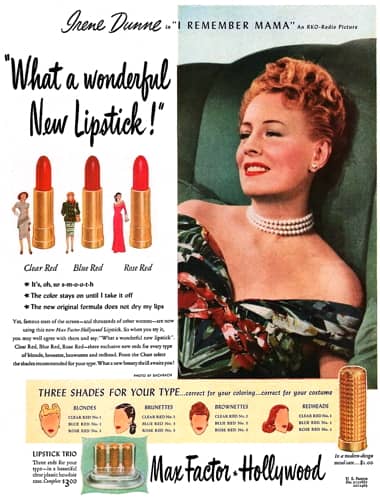
1947 Max Factor Lipstick.

1948 Max Factor Pan-Stik in seven shades: Fair, Natural, Medium, Olive, Deep Olive, Natural Tan and Golden Tan.
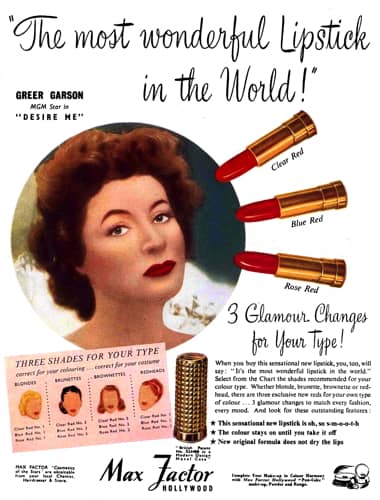
1948 Max Factor Lipstick.
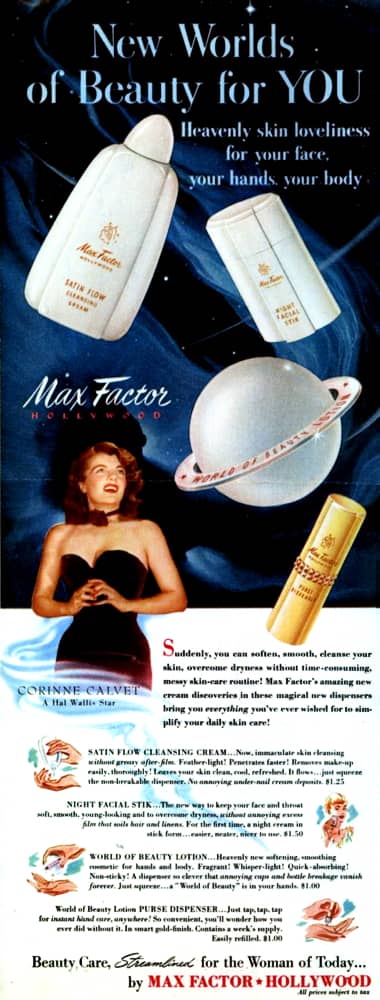
1950 Max Factor Satin Flow Cleansing Cream, Night Facial Stik, World of Beauty Lotion and World of Beauty Lotion Purse Dispenser.
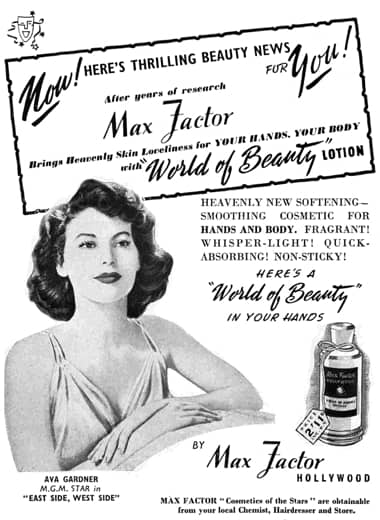
1950 Max Factor World of Beauty Lotion (Britain). The squeezable, plastic container had become available there by 1951
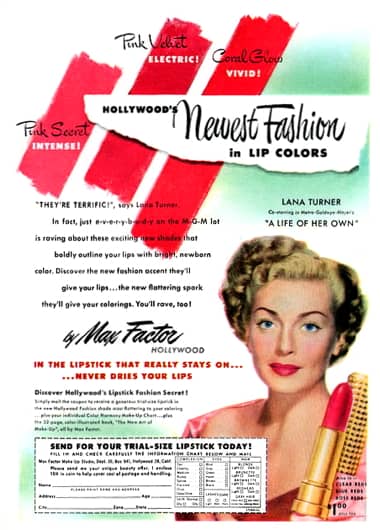
1950 Max Factor Lipstick in three new shades: Pink Secret, Pink Velvet nad Coral Gloss.
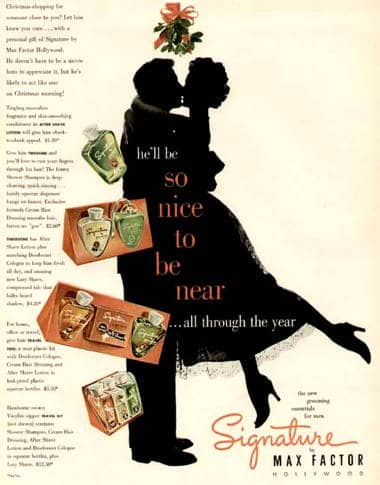
1951 Max Factor’s Signature men’s line, the first men’s toiletries range the company produced.
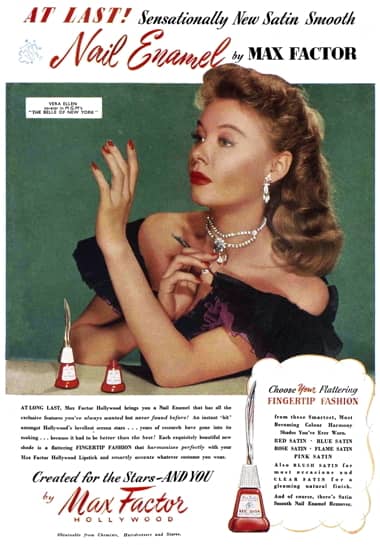
1951 Max Factor Nail Enamel (Britain).
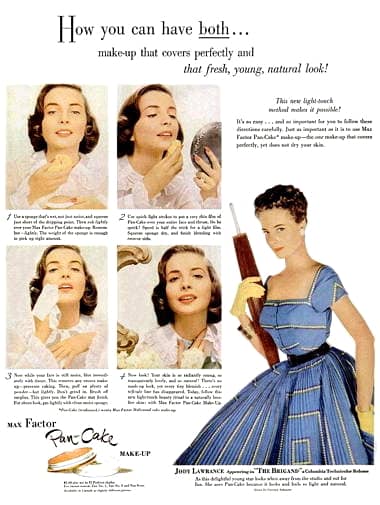
1952 Max Factor Pan-Cake.
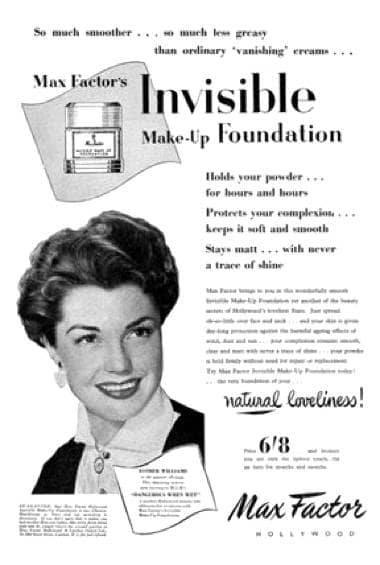
1953 Max Factor Invisible Foundation.
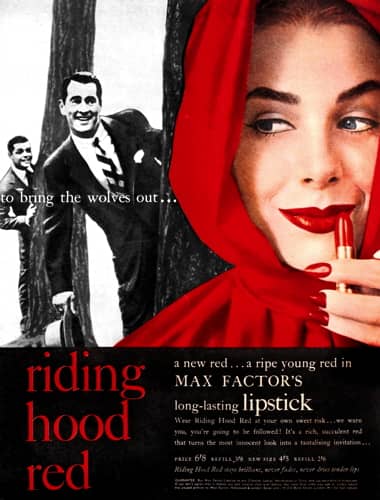
1953 Color-Fast lipstick, in Riding Hood Red.

1954 Max Factor Color-Fast Lipstick.
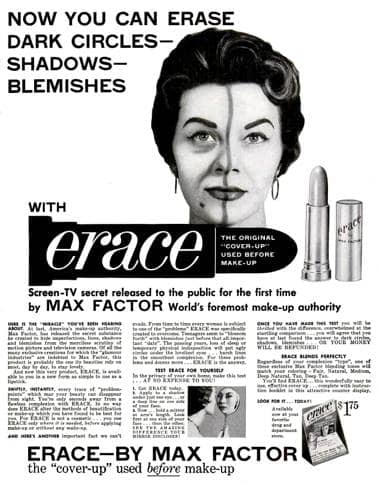
1954 Max Factor Erace in five shades (Fair, Medium, Deep Natural, Tan and Deep Tan) with White Erace released in 1968. This was not the first stick concealer; that honour goes to Covermark’s Spot-Stick introduced in 1936.
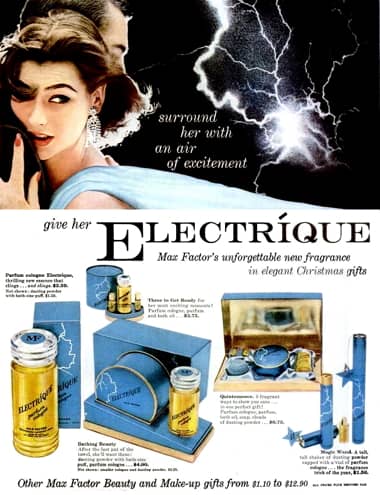
1954 Max Factor Electríque as a perfume, cologne, bath oil, soap and dusting powder.
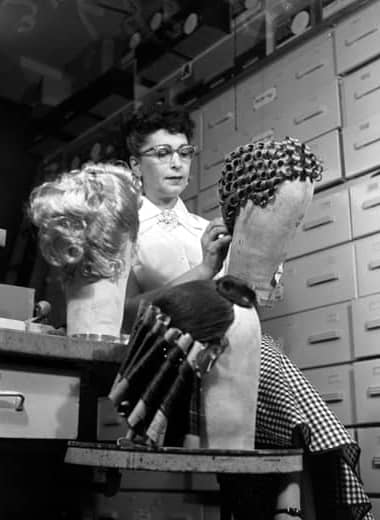
1954 Wig-making at the Max Factor Studio in Los Angeles, California. Max factor continued to maintain its interest in hair and wigs until the Hair Department was closed down in 1973.
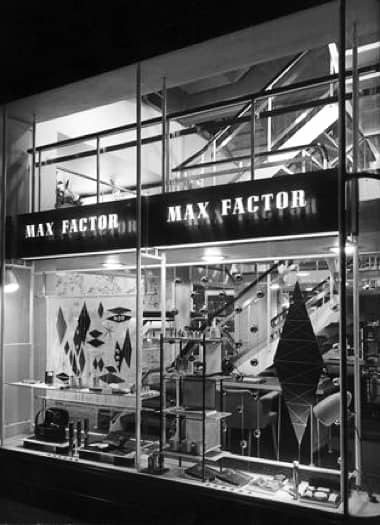
1954 Max Factor Salon and Make-up Studio at 28 Old Bond street, London.
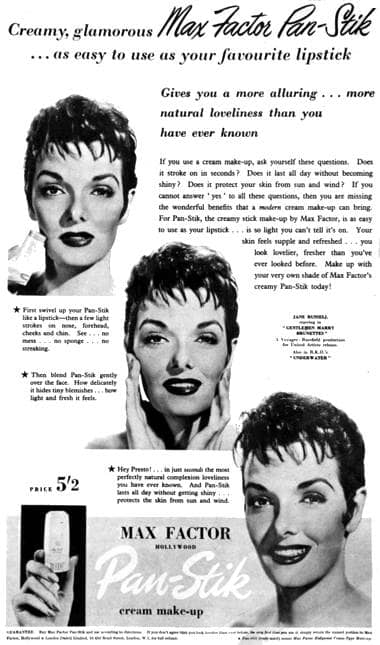
1955 Max Factor Pan-Stik. One of the last Max Factor products to used an endorsement from a Hollywood movie star.

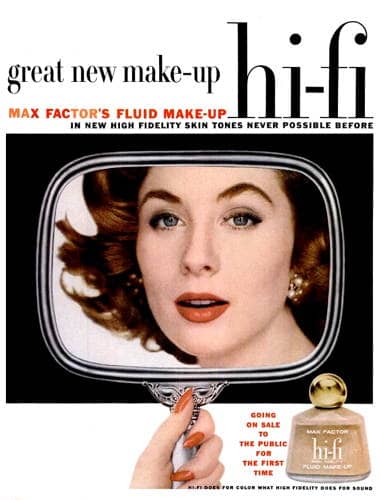
1955 Max Factor Hi-Fi Fluid Make-Up (Full spread above).

1955 Max Factor Secret Key.
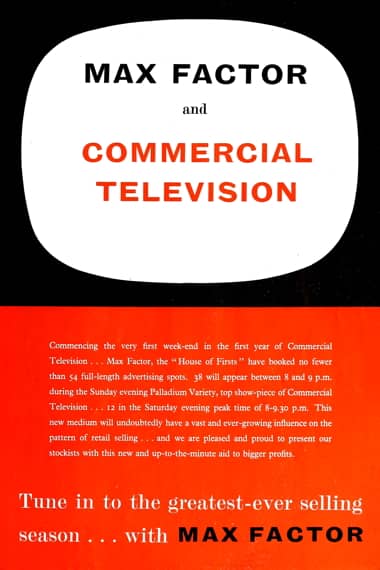
1955 Industry announcement that Max Factor would begin advertising on commercial television in Britain.
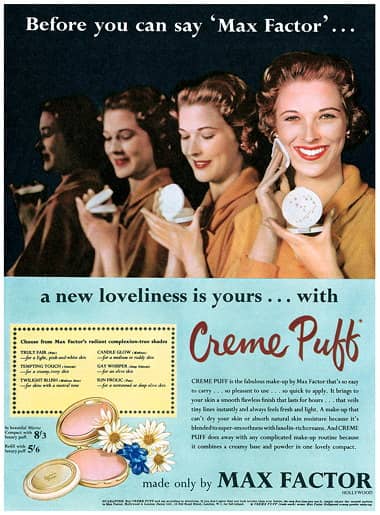
1956 Max Factor Creme Puff.
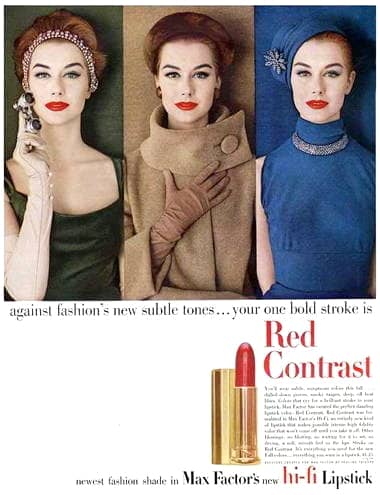
1956 Max Factor Hi-Fi Lipstick. Shade: Red Contrast.
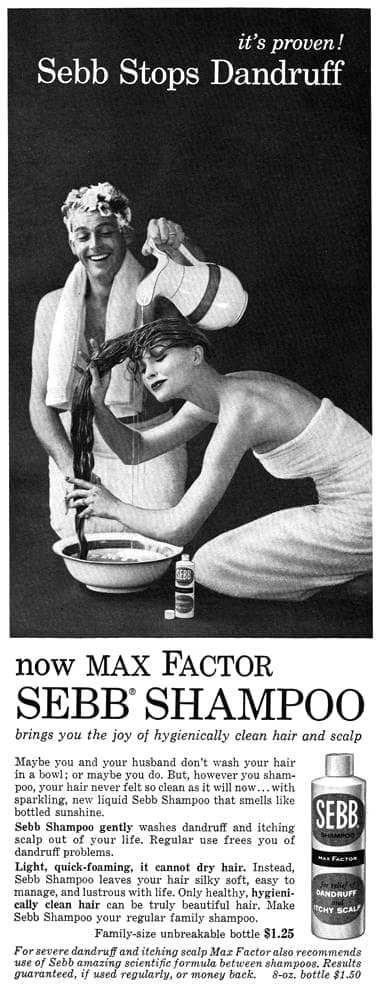
1957 Max Factor Sebb. In 1955, Max Factor established a Pharmaceutical Specialties Division and produced their first product, Sebb, an anti-dandruff shampoo. The division lasted until 1958 when it was absorbed back into the rest of the U.S. company.

1957 Max Factor Calypso Beat.

1958 Ground breaking ceremony at the new factory site at McCaddon Place. Albert C. Martin Jr. (left), Max Factor Jr., Davis Factor, and Ernest W. Hahn (right). Albert C. Martin & Associates were the site architects and engineers. They had previously worked on the remodelling of Highland Avenue. Ernest W. Hahn was the contractor for the site.
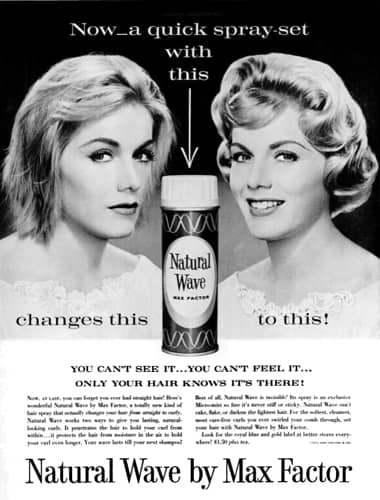
1958 Max Factor Natural Wave.
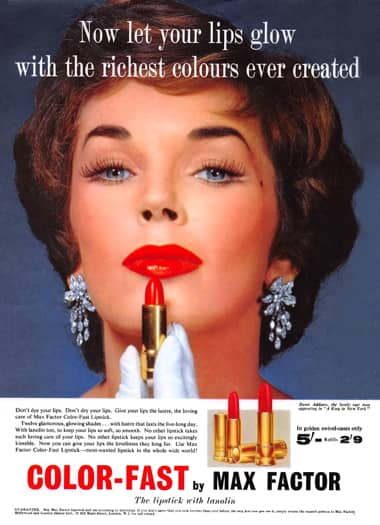
1958 Max Factor Color-Fast Lipstick.
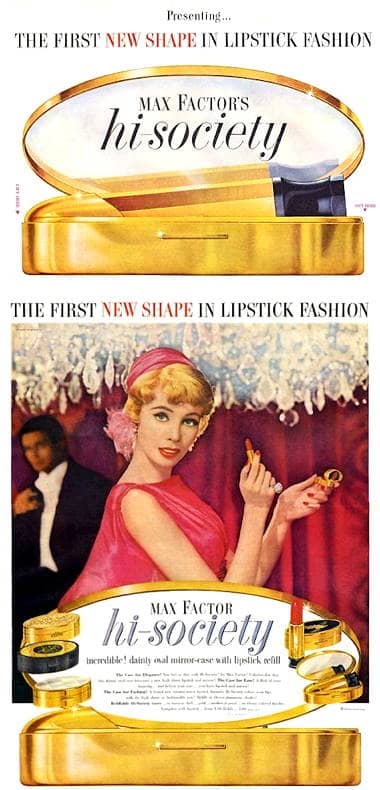
1958 Max Factor Hi-Society Lipsticks. The lipsticks were sold in an oval case which had a mirror in the lid. Taking up not much more room in a handbag than an ordinary lipstick they enabled a woman to touch up a lipstick without the need to also get out her compact.

1959 Max Factor Mascara Wand.
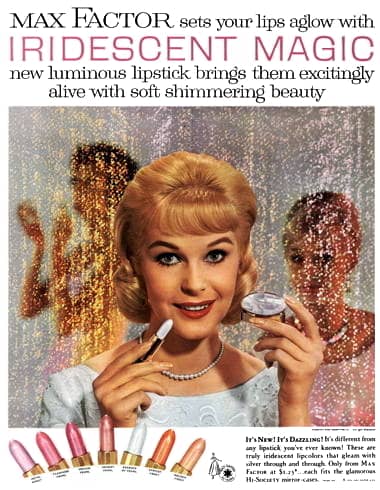
1959 Max Factor Iridescent Magic Lipstick in seven shades: Petal Frost, Flamingo Pearl, Orchid Pearl, Desert Pearl, Essence of Pearl, Apricot Frost, Golden Frost. Essence of Pearl could be used under and over any other lipstick to add iridescence to the shade.
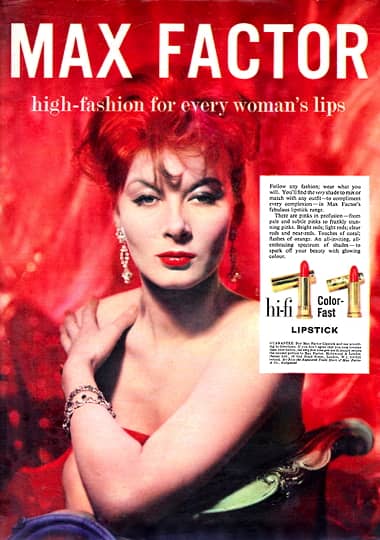
1959 Max Factor Color-Fast and Hi-Fi Lipsticks.

1959 Max Factor Hi-Society Cases.

Display case for Hi-Society cases and lipsticks.
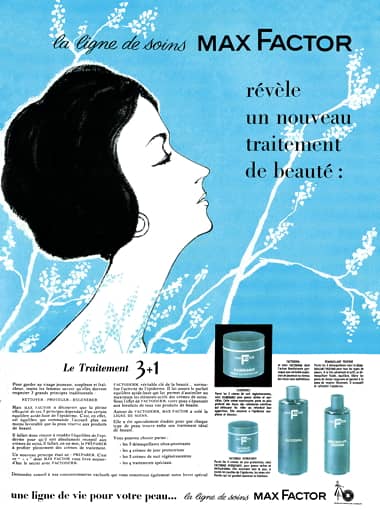
1959 Max Factor Secret Key Treatments (France).
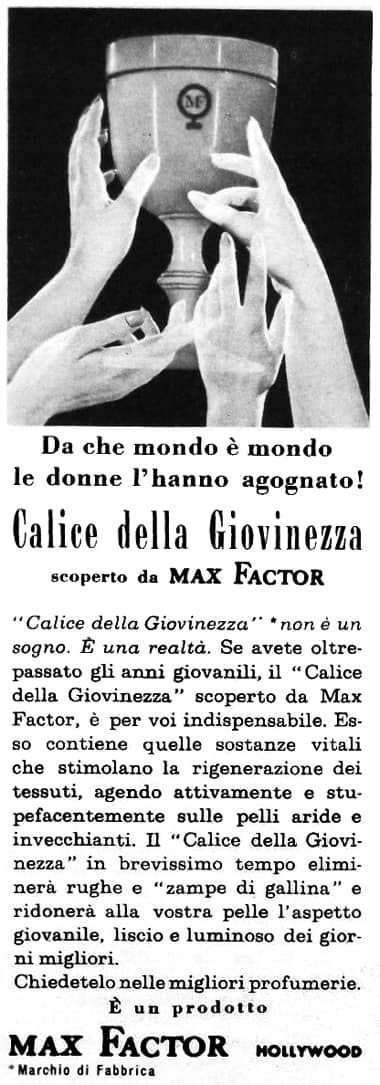
1959 Max Factor Cup of Youth (Italy).
